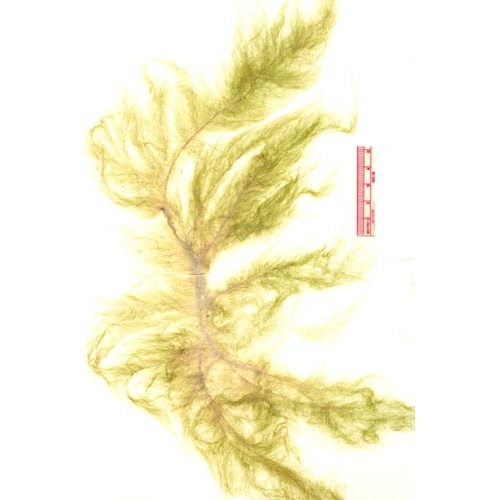
Main Page | References
Cladophora sericea (Huds.) Kütz.

Cladophora sericea (Huds.) Kütz.
Description: Plant filamentous, monosiphonous, profusely to very sparsely branched, composed of multinucleate cells with numerous plastids arranged in a reticulum. Growth by apical or intercalary cell divisions. Thallus 2 to 18 cm tall, usually simple, pale to dark green when matted, silky in texture. On larger plants branches form clusters 1/4 to 1/3 of the total length of the plants, secondary branches in turn elongate. Second order branches frequently attached in groups of three or four at the lower nodes. All orders densely branched with long and short, old and young laterals mixed. Apical cells 15-20 mm diam., 4-5 times longer. Cells of main axes are conspicuous, 80-160 mm diam., two to four times larger than cells of secondary axes. Laterals abundant, opposite, or secund.Introduction and Origin: Native to Hawaii.
Hawaiian Distribution: Midway, Maro, Kauai, Oahu, Maui, Hawaii
Habitat: Subtidal to lower intertidal, near low tide line to 2 m deep, attached to rocks and hard substrates.
Environmental Effects: Cladophora sericea grows on coral heads, competing with these organisms for light and nutrients, and is probably one of the factors affecting coral decline in West Maui.
World Distribution: Primarily European. Worldwide: Australia, Pacific Ocean, Indian Ocean, Atlantic Ocean, Mediterranean and the Caribbean. Indigenous to the Hawaiian Islands.
Commercial Interests: Cladophora sericea blooms cover vast portions of the reef, overgrowing corals and other algae species, and also making it less attractive for underwater tourism.
Rate of Spread / Method: Very high growth rates. Dispersal by vegetative growth, and motile gametes and zoospores.
Factors likely to influence Spread and Distribution: Irradiance, temperature, high nutrients availability.
Reasons for Success: Rapid growth rate, high nutrients availability. Low surface to volume ratio ensures fast nutrient uptake. Diffuse growth of filaments facilitates vegetative propagation through fragmentation.
Control Methods: None used.
References: